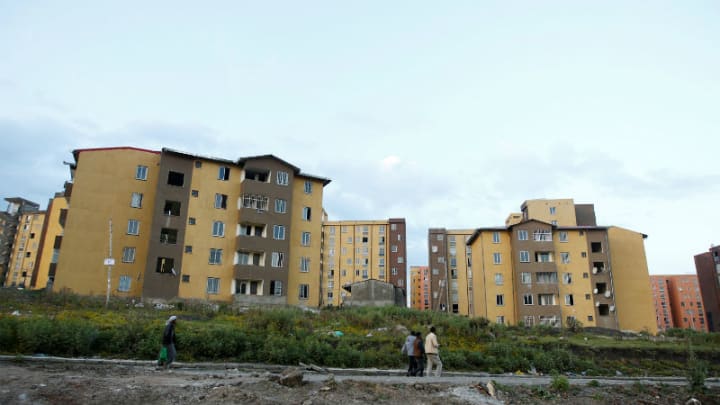The 21st century belongs to the city. Currently, about just over half of the world’s population lives in cities, but according to the U.N., this number will grow to 68% by 2050. With the majority of people transitioning to urban areas, especially in countries across the global south, cultures all over the world have had to adapt to greater density and the housing typologies that come with it, including verticality.
Our housing preferences and our living habits are dramatically changing as we move away from the land and begin to live in the sky.
Vertical living is necessary to cut urban housing costs and meet Sustainable Development Goal 11: to make cities and human settlements inclusive, safe, resilient and sustainable. While slashing housing construction costs are often the focus of housing policymakers, there are other, often overlooked, costs such as land and infrastructure upgrades, that need more attention if formal affordable housing in growing urban areas is to become a reality.
In rapidly growing cities in the global south, going vertical can slash housing costs by more than half and make housing more affordable for two major reasons:
1. Titled land is rare and expensive. Many countries still struggle with issues linked to tenure security, pushing up the prices of properties with clean titles. The little titled and serviced land available is subject to land use economics under which more profitable assets are built first and affordable housing inevitably comes last, if at all.
2. Infrastructure doesn’t keep up with sprawl and developers often take on these costs themselves. The cost of infrastructure expansion can be much higher for single-family units further from urban cores than for flats which can build on existing infrastructure.
Yet the benefits of housing density are not recognized equally in all contexts. While density and verticality have already made significant improvements in some parts of Asia, housing professionals often meet opposition to verticality in many African countries.
At the Affordable Housing Institute, we are constantly told that verticality will be impossible to achieve and cultural preferences are set in stone. For this reason, government-sponsored housing projects still tend toward building single-family housing units on large lots that are only accessible to a minority of households. Such development models require specific tenure types, as well.
Social rental allows for affordable housing solutions, but the desire to own is a powerful motivator for many. This motivation leads to the development of single-family homes which cover larger footprints but miss out on the benefits of densification and can actually cause more problems for cities in the long-term by contributing to urban sprawl.
Historically, this makes sense. All cultures have had strong connections to the land they live on and have had to embrace verticality out of necessity. As long as single-family units are still available and affordable close to urban areas, households will choose to live in them. This means that regulation has often failed to keep up with increased urbanization and enable vertical living.
Countries as different as Guinea and Haiti lack active condominium laws making the purchase and sale of apartments a legal hurdle which the systems have had difficulties overcoming. Instead, apartment buildings are sold to landlords and investors who will rent out the individual units. Households miss out on what might be an affordability ownership option.
Many cities are now approaching a tipping point, however. As urbanization continues, cities need to plan strategic infrastructure improvements to manage population growth. Housing is an essential aspect of planning for growth in urban environments, but formal residential development is severely lagging behind urbanization rates.
This can lead to, somewhat paradoxically, horizontal density through the proliferation of slums and sprawl. Slum upgrading programs worldwide are seeking to transform horizontal informal density into vertical planned neighborhoods. This transition can be very challenging and expensive after the fact, as households need to be relocated and social acceptance is often difficult.
Cities cannot hold back this density, which would be like trying to hold back a tsunami, but need to plan for and invest in formal densification of affordable housing. So what can cities do to maximize the benefits of their growing populations?
Policymakers need to incentivize “smart density” before cities reach their tipping point and are forced to deal with the consequences of runaway urban sprawl. Smart density does not refer to clustering households in high-rise buildings. It means building culturally appropriate multistoried buildings which attract both families and businesses and, in the process, creates vibrant neighborhoods with economic opportunities.
Ethiopia has led the way by providing hundreds of thousands of highly subsidized condominium units within the capital, changing both the city’s skyline and urban culture. The government of Rwanda is developing policies that will make vertical living more attractive and cheaper through zoning exemptions and subsidies for developers.
Other countries should follow their lead and ensure that smart density is incentivized from the beginning by passing condominium laws, enforcing smart zoning standards, and ensuring that public subsidies are directed toward apartments instead of detached single-family units.
Though we all wish to have our own garden, urban land is not limitless and well-planned cities require density, affordability, and access to transportation. Governments should work today to ensure that these features are adopted before cities swell in size and urban sprawl creates air quality, transportation, and affordability issues.
Only then can we hope to meet the challenge of providing inclusive, safe, and resilient housing for all.
Source: devex.




